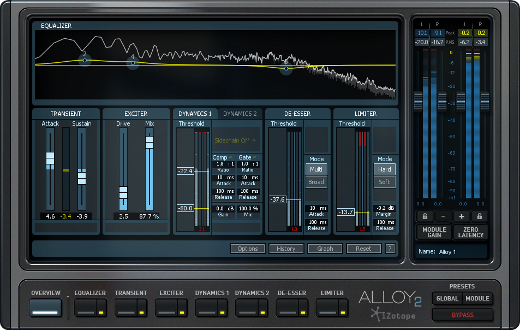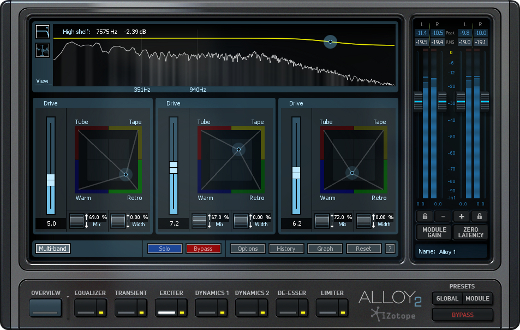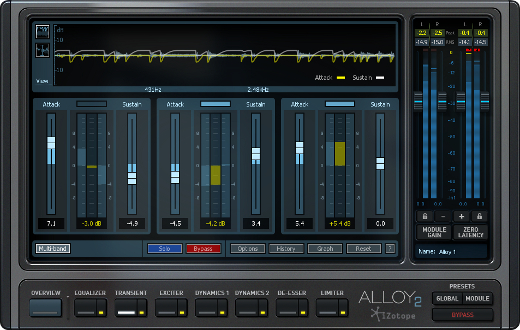Research & Development: Inside the Making of Alloy 2 from iZotope
When iZotope launched Alloy 2 back in August, the release caught our eye.
When a smart software company has a hit on its hands, as it did with the original Alloy mixing tools suite, how does it improve on that? A plugin designed for music, audio post, and broadcast use, Alloy 2 promised to take things further with its six highly visual tools: Equalizer, Dynamics, Exciter, De-Esser, Transient Shaper, and Limiter (see the full details on Alloy 2 here).
For our latest edition of “Research & Development,” we asked iZotope to explain their thought process as they updated Alloy. Nick Dika, Senior Product Manager for iZotope, obliged and then some — to see how a design team takes a popular plugin to the next level, read on.
What was the initial inspiration for Alloy? What niche or hole in the market was it created to fill?
Quite simply, our customers’ creative uses for Ozone inspired Alloy.
We designed Ozone to be a mastering processor, to be used on a two track mix. But, as you know, audio folks are good at bending the rules for creative gain. So we heard all kinds of stories about people using Ozone to slam drum busses and loops, fatten up guitars… someone on gearslutz even nominated Ozone for “best vocal channel strip” in a thread.
At some point we looked at all the feature requests we were getting for things like low latency, sidechaining, de-essing and lower CPU usage and decided it was time to make a whole new processor for tracks and busses rather than trying to make Ozone a Swiss Army Knife. So we decided to make something like a channel strip, but with more depth and a more 21st Century take. That’s how Alloy came to be.
What were your goals for the initial adoption of the first version of Alloy? Did it meet your expectations?
Alloy 1 was a huge hit with Ozone users, so I think we did a good job of making it a worthy mixing counterpart to Ozone. That was the goal we first set out for, so I’d say we met it. We also gained a lot of new fans which was great.
I think the approach of having a set of high quality mixing tools integrated into one plugin was one of the stronger selling points — it can really speed up the way you work. Of course there have always been “channel strips.” But people liked the fresh approach of Alloy, and that we included more specialized tools like transient shaping, multiband sidechaining and parallel dynamics options. So we were pleased that people seemed to really “get it.”
What did you learn from the rollout of the original Alloy – what was surprising/unexpected for you in terms of how users were integrating it into their workflow, and using some of the features of the plugin?
There were lots of great revelations. Since I’ve been dwelling on the positive until now, I’ll address some of the negative feedback with this one. We were surprised at first that we got mixed reviews on the exciter and transient shaper in Alloy 1. We spent a ton of time using them and listening to them during development, so we were disappointed by the criticism by some of the reviewers and customers.
The strangest part is that the feedback was so polarized — people either loved them or hated them. It took some pondering to realize that it wasn’t necessarily that we got the sound or the DSP wrong. It’s that we got the controls wrong. It’s not that you couldn’t get a good sound, it was just too easy to dial in a bad one! That was a huge product design lesson for me personally. We really had to take a step back and think about how to present these tools to someone who’s opening the plugin for the first time. Because if you don’t like the way something sounds in a couple minutes, are you really going to stick with it? Probably not.
True that! From there, how did that feedback inspire you to start developing the next version of Alloy, namely Alloy 2?
Those pieces of feedback were some of the core reasons for doing a Version 2. The Alloy team really came through in making the transient shaper and exciter sound awesome while also making things simpler to use.
At first Aaron Wishnick, one of our DSP engineers, brought us this new version of the transient shaper that only had two controls instead of 4. Brett Bunting (Alloy’s other Product Manager) and I were just looking at each other scratching our heads — “We can’t take controls out! That’s not supposed to happen in a version 2! You’re supposed to add more controls right??”
But in the end, we found we didn’t need to add more control because it just caught transients so much better and sounded so much more natural on everything we listened to. It’s so much easier to use on mixed drums for example. And multiband mode is just awesome when you want more surgical control.
So what’s different about the way engineers/producers/artists can use Alloy 2, as opposed to the original Alloy?
They’ll be able to get to a sound they like much quicker. We added new visualizations that help you set up the dynamics, transient and de-esser controls quickly by seeing their effect on the audio’s waveform.
One of my favorite additions this time around is the new Overview window. This is one thing that will save both new and advanced users a ton of time and energy. Basically, it shows you the most relevant controls for any of Alloy’s active processors. So if you are only using an EQ and Compressor, you get a nice compact view that shows you only their controls. Or if you’re using two compressors in parallel or series, you can see their controls side by side easily to fine tune their settings.
If you’re new to Alloy and browsing presets, you see the controls that matter most. Or if you’re the kind of person who always starts from scratch, you don’t have to put in any extra work to get a simplified overview, it just appears based on what Alloy modules you’re using.
What’s the most challenging aspect of designing a new variation of an existing product, as you’ve done with Alloy 2?
Any time you change something you have to be aware that even if you think it’s an improvement, someone out there likes it the way it was in the old version.
We definitely ruffled some of our beta testers’ feathers by simplifying the exciter and transient shaper, for example. But again, we really were looking out for the big picture of sound quality and usability, and in the end I think we won almost everyone over with the improvements we made — it’s just far, far easier to get a great sound, period.
That said, there were definitely a few things on the chopping block that we decided to slide back in thanks to the urging of beta testers and iZotope employees. For example, a lot of people liked the simple stereo width control in the exciter, which was kind of an afterthought in Alloy 1 that we were considering cutting. So we kept it.
Additionally, what are some of the particular challenges of refining/improving a plugin, as opposed to doing that for hardware?
Really good question! I’ve been thinking about that difference a lot recently. I think in software engineering and design, it is hard to choose what not to do. In hardware you have these very physical constraints — cost of components, manufacturing costs, the laws of physics, and other inconvenient things like that! In software you have increasingly powerful computers and far fewer practical limits. The only limits are how much time you have and how talented your engineers are.
The trap you can easily fall into is to just keep piling on more sliders, options and menus. It takes a lot of discipline and restraint to take a step back and say “Yes, that’s a cool idea, but will anyone ever really need or want that feature?” You really have to think about the specific people you are making your software for, and what you believe they will need. Everyone on the Alloy team took that to heart and I think it shows for this update.
Those are some great insights on the development process. Lastly, why is product evolution an essential part of what you do – what are the market forces that make new product features and models a necessity for manufacturers like iZotope?
Well, for us, we are perfectionists and we are never content with the last version of whatever we’ve done! We always have more ideas of how to improve or refine a tool like Alloy, so some of the product evolution is self-motivated. As mentioned before, we also take our users’ opinions and requests seriously which is a huge part of that self-motivation.
I guess sometimes we think about market forces. But we’re not in a commodity market, we are in a very small passionate niche where people own more than one EQ based on the “vibe” each one has, so things aren’t clear cut.
The most important thing is to make tools that inspire people to do their best work. As long as we can do that, we will always have new customers and we will always have to innovate to keep up with them.
— David Weiss
Please note: When you buy products through links on this page, we may earn an affiliate commission.









